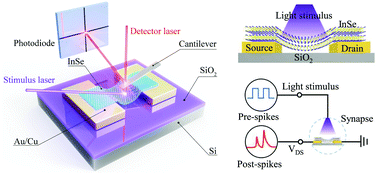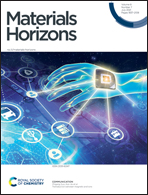Flexo-photoelectronic effect in n-type/p-type two-dimensional semiconductors and a deriving light-stimulated artificial synapse†
Abstract
Flexoelectricity and photoelectricity with their coupled effect (the so-called flexo-photoelectronic effect), are of increasing interest in the study of electronics and optoelectronics in van der Waals layered semiconductors. However, the related device design is severely restricted owing to the ambiguous underlying physical nature of flexo-photoelectronic effects originating from the co-manipulation of light and strain-gradients. Here, flexoelectric polarization and the flexo-photoelectronic effect of few-layered semiconductors have been multi-dimensionally investigated from high-resolution microscopic characterization on the nanoscale, physics analysis, and deriving a device design. We found that two back-to-back built-in electric fields form in bent InSe and WSe2, and greatly modulate the transport behaviors of photogenerated carriers, further facilitating the separation of photogenerated electron–hole pairs and trapping the holes/electrons in InSe or WSe2 channels, recorded in realtime by a home-made technique of lighting Kelvin probe force microscopy (KPFM). The slow release of trapped carriers contributes to the photoconductance relaxation after illumination. Utilizing the photoconductance relaxation, a light-stimulated artificial synapse based on the flexo-photoelectronic effect of bent InSe has been achieved. Significantly, all the pair-pulse facilitation (PPF) behavior, spike frequency-dependent excitatory post-synaptic current (EPSC) and the transition from short-term memory (STM) to long-term memory (LTM) have been successfully realized in this artificial synapse. This work adds to the investigation of flexo-photoelectronic effects on 2D optoelectronics, and moves towards the development of 2D neuromorphic electronics.



 Please wait while we load your content...
Please wait while we load your content...